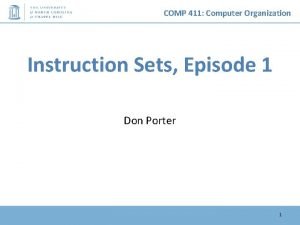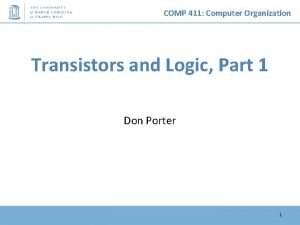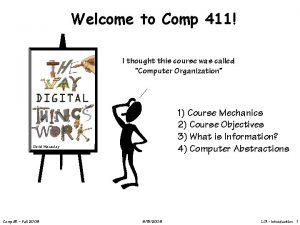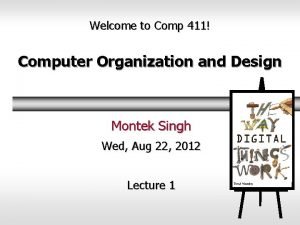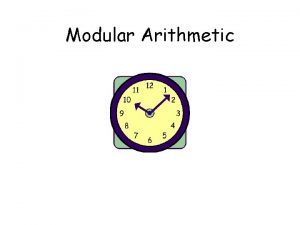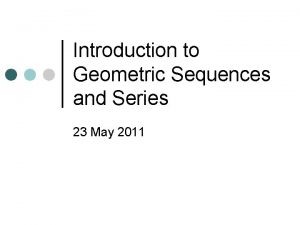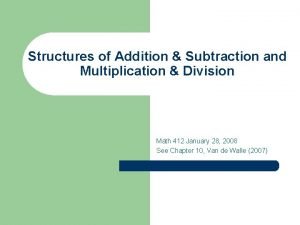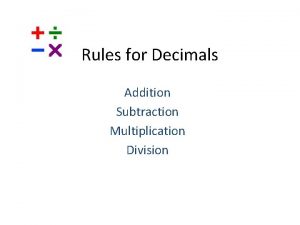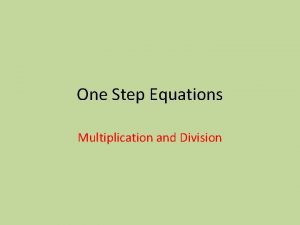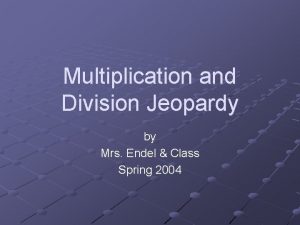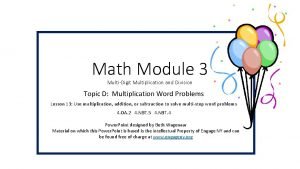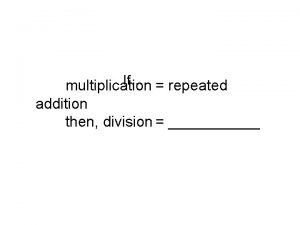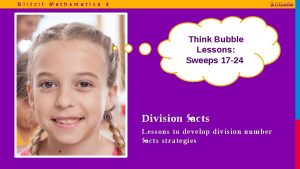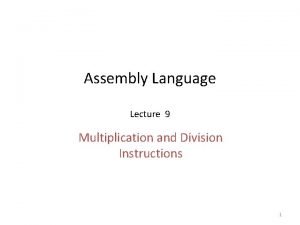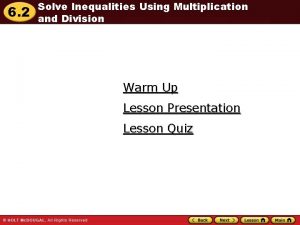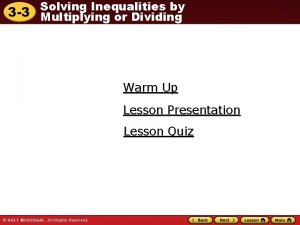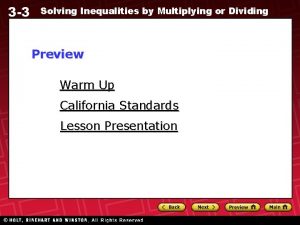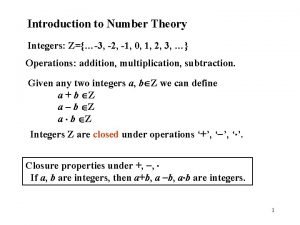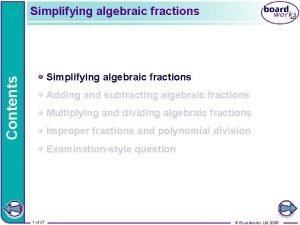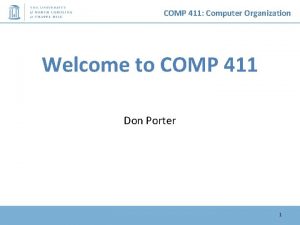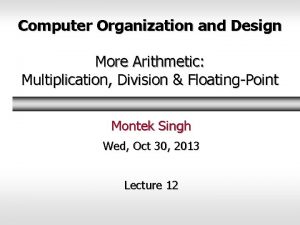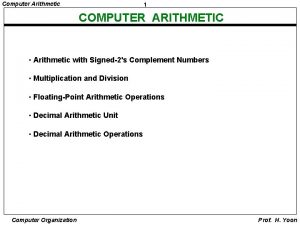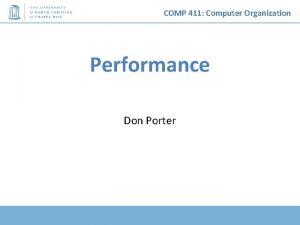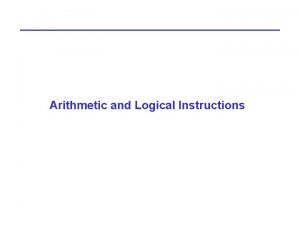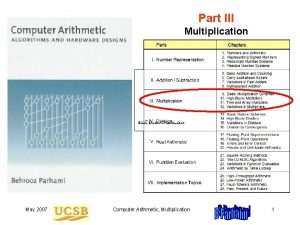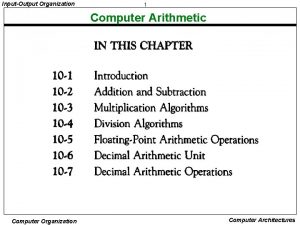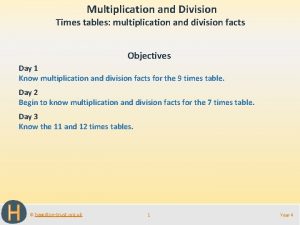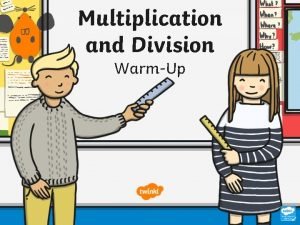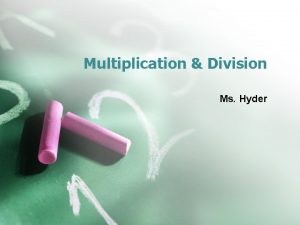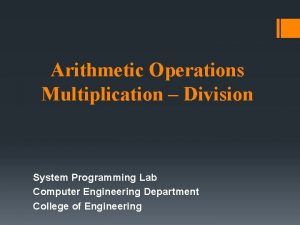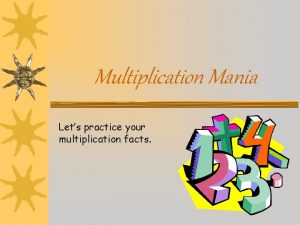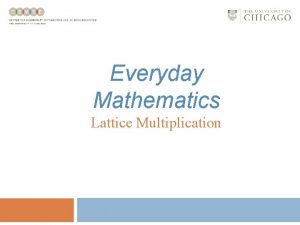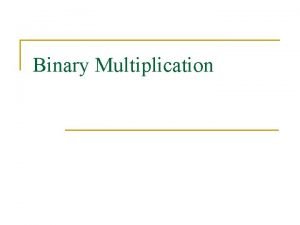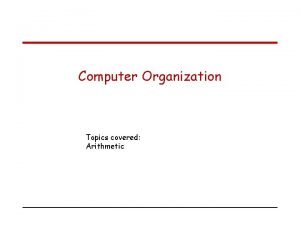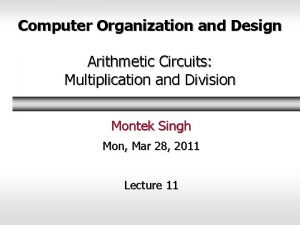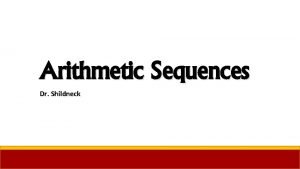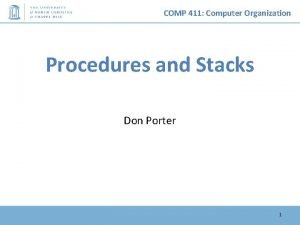COMP 411 Computer Organization More Arithmetic Multiplication Division
































- Slides: 32

COMP 411: Computer Organization More Arithmetic: Multiplication, Division, and Floating-Point Don Porter Lecture 13 1

COMP 411: Computer Organization Topics • Brief overview of: – integer multiplication – integer division – floating-point numbers and operations Reading: Study Chapter 3. 3 -3. 5

COMP 411: Computer Organization Binary Multipliers The key trick of multiplication is memorizing a digit-to-digit table… Everything else is just adding × 0 1 2 3 4 5 6 7 8 9 0 0 0 1 2 3 4 5 6 7 8 9 2 0 2 4 6 8 10 12 14 16 18 3 0 3 6 9 12 15 18 21 24 27 4 0 4 8 12 16 20 24 28 32 36 5 0 5 10 15 20 25 30 35 40 45 6 0 6 12 18 24 30 36 42 48 54 7 0 7 14 21 28 35 42 49 56 63 8 0 8 16 24 32 40 48 56 64 72 9 0 9 18 27 36 45 54 63 72 81 × 0 1 0 0 0 1 You’ve got to be kidding… It can’t be that easy!

COMP 411: Computer Organization Binary Multiplication The “Binary” Multiplication Table Hey, that looks like an AND gate Binary multiplication is implemented using the same basic longhand algorithm that you learned in grade school. X 0 1 0 0 0 A 3 x B 3 1 0 1 Aj. Bi is a “partial product” A 3 B 1 + A 3 B 3 A 2 B 2 A 1 B 1 A 0 B 0 A 3 B 0 A 2 B 0 A 1 B 0 A 0 B 0 A 2 B 1 A 1 B 1 A 0 B 1 A 3 B 2 A 2 B 2 A 1 B 2 A 0 B 2 A 2 B 3 A 1 B 3 A 0 B 3 Multiplying N-digit number by M-digit number gives (N+M)-digit result Easy part: forming partial products (just an AND gate since B I is either 0 or 1) Hard part: adding M, N-bit partial products

COMP 411: Computer Organization Multiplication: Implementation Start Multiplier 0 = 1 1. Test Multiplier 0 = 0 1 a. Add multiplicand to product and place the result in Product register 2. Shift the Multiplicand register left 1 bit 3. Shift the Multiplier register right 1 bit Hardware Implementation 32 nd repetition? Flow Chart No: < 32 repetitions Yes: 32 repetitions Done

COMP 411: Computer Organization Second Version Multiplicand Start 32 bits Multiplier 0 = 1 Multiplier Shift right 32 -bit ALU 1. Test Multiplier 0 = 0 32 bits Product Shift right Write Control test 64 bits 1 a. Add multiplicand to the left half of the product and place the result in the left half of the Product register 2. Shift the Product register right 1 bit 3. Shift the Multiplier register right 1 bit More Efficient Hardware Implementation 32 nd repetition? Flow Chart No: < 32 repetitions Yes: 32 repetitions Done

COMP 411: Computer Organization Final Version Start Product 0 = 1 1. Test Product 0 = 0 1 a. Add multiplicand to the left half of the product and place the result in the left half of the Product register 2. Shift the Product register right 1 bit Even More Efficient Hardware Implementation! 32 nd repetition? The trick is to use the lower half of the product to hold the multiplier during the operation. No: < 32 repetitions Yes: 32 repetitions Done

COMP 411: Computer Organization Example for second version Iteration Step Multiplier Multiplicand Product 0 Initial 1011 0010 0000 1 Test true shift right 1011 0101 0010 0000 0001 0000 2 Test true shift right 0101 0010 0011 0000 0001 1000 3 Test false shift right 0010 0001 1000 0000 1100 4 Test true shift right 0001 0000 0010 1100 0001 0110

COMP 411: Computer Organization What about the sign? • • Positive numbers are easy How about negative numbers? – Please read signed multiplication in textbook (Ch 3. 3)

COMP 411: Computer Organization Can do we faster? • Instead of iterating in time… • How about iterating in space…? – repeat circuits in space • consume more area • but faster computation

COMP 411: Computer Organization Simple Combinational Multiplier • “Array Multiplier” – repetition in space, instead of time – Components used: • N*(N-1) full adders • N 2 AND gates

COMP 411: Computer Organization Simple Combinational Multiplier • Propagation delay – Proportional to N • N is #bits in each operand – ~ 3 N*tpd, FA

COMP 411: Computer Organization Division Hardware Implementation See example in textbook (Fig 3. 10) Flow Chart

COMP 411: Computer Organization Floating-Point Numbers & Arithmetic Reading: Study Chapter 3. 5

COMP 411: Computer Organization Why do we need floating point? • Several reasons: – Many numeric applications need numbers over a huge range • e. g. , nanoseconds to centuries – Most scientific applications require real numbers (e. g. ) • But so far we only have integers. What do we do? – We could implement the fractions explicitly • e. g. : ½, 1023/102934 – We could use bigger integers • e. g. : 64 -bit integers – Floating-point representation is often better • has some drawbacks too!

COMP 411: Computer Organization Recall Scientific Notation • Recall scientific notation from high school – Numbers represented in parts: • 42 = 4. 200 x 101 • 1024 = 1. 024 x 103 • -0. 0625 = -6. 250 x 10 -2 • Arithmetic is done in pieces 1024 1. 024 x 103 - 42 -0. 042 x 103 = 982 0. 982 x 103 = 9. 820 x 102 Significant Digits Exponent Before adding, we must match the exponents, effectively “denormalizing” the smaller magnitude number We then “normalize” the final result so there is one digit to the left of the decimal point and adjust the exponent accordingly.

COMP 411: Computer Organization Multiplication in Scientific Notation • Is straightforward: – – – Multiply together the significant parts Add the exponents Normalize if required • Examples: 1024 1. 024 x 103 x 0. 0625 6. 250 x 10 -2 = 64 6. 400 x 101 42 4. 200 x 101 x 0. 0625 6. 250 x 10 -2 = 2. 625 26. 250 x 10 -1 = 2. 625 x 100 (Normalized) In multiplication, how far is the most you will ever normalize? In addition?

COMP 411: Computer Organization Binary Floating-Point Notation • IEEE single precision floating-point format – Example: (0 x 42280000 in hexadecimal) 0 10000100 0 1 0 0 0 0 0 “S” Sign Bit “E” Exponent + 127 “F” Significand (Mantissa) - 1 • Three fields: – Sign bit (S) – Exponent (E): Unsigned “Bias 127” 8 -bit integer • E = Exponent + 127 • Exponent = 10000100 (132) – 127 = 5 – Significand (F): Unsigned fixed-point with “hidden 1” • Significand = “ 1”+ 0. 01010000000000 = 1. 3125 – Final value: N = -1 S (1+F) x 2 E-127 = -10(1. 3125) x 25 = 42

COMP 411: Computer Organization Example Numbers • One – Sign = +, Exponent = 0, Significand = 1. 0 • • • 1 = -10 (1. 0) x 20 S = 0, E = 0 + 127, F = 1. 0 – ‘ 1’ 0 01111111 000000000000 = 0 x 3 f 800000 • One-half – Sign = +, Exponent = -1, Significand = 1. 0 • ½ = -10 (1. 0) x 2 -1 • S = 0, E = -1 + 127, F = 1. 0 – ‘ 1’ • 0 01111110 000000000000 = 0 x 3 f 000000 • Minus Two – Sign = -, Exponent = 1, Significand = 1. 0 • -2 = -11 (1. 0) x 21 • 1 1000000000000 = 0 xc 0000000

COMP 411: Computer Organization Zeros • How do you represent 0? – Sign = ? , Exponent = ? , Significand = ? • Here’s where the hidden “ 1” comes back to bite you • Hint: Zero is small. What’s the smallest number you can generate? – Exponent = -127, Signficand = 1. 0 – -10 (1. 0) x 2 -127 = 5. 87747 x 10 -39 • IEEE Convention – When E = 0, we’ll interpret numbers differently… • 0 000000000000000 = exactly 0 (not 1 x 2 -127) • 1 0000000000000000 = exactly -0 (not -1 x 2 -127) Yes, there are “ 2” zeros. Setting E=0 is also used to represent a few other small numbers besides 0 (“denormalized numbers”, see later).

COMP 411: Computer Organization Infinities • IEEE floating point also reserves the largest possible exponent to represent “unrepresentable” large numbers – Positive Infinity: S = 0, E = 255, F = 0 • 0 1111 000000000000 = +∞ • 0 x 7 f 800000 – Negative Infinity: S = 1, E = 255, F = 0 • 1 1111 000000000000 = -∞ • 0 xff 800000 – Other numbers with E = 255 (F ≠ 0) are used to represent exceptions or Not-A-Number (NAN) • √-1, -∞ x 42, 0/0, ∞/∞, log(-5) – It does, however, attempt to handle a few special cases: • 1/0 = + ∞, -1/0 = - ∞, log(0) = - ∞

COMP 411: Computer Organization Low-End of the IEEE Spectrum 0 denorm gap 2 -127 2 -126 2 -125 normal numbers with hidden bit • “Denormalized Gap” – Because of the hidden 1, there’s a relatively large gap between 0 and the smallest +ve “normalized” number: • 0. 0000 0000 • 1. 0000 0000 x 2 -127 • 1. 0000 0000 001 x 2 -127 – The gap can be filled with “denormalized” numbers: • • 0. 0000 0000 001 x 2 -126 1 x 2 -149 (tiniest!) 0. 0000 0000 010 x 2 -126 0. 0000 0000 011 x 2 -126

COMP 411: Computer Organization Low-End of the IEEE Spectrum 0 denorm gap 2 -127 2 -126 normal numbers with hidden bit • Denormalized Numbers – those without the hidden 1 – if the E field is 0 • there is no hidden 1 the number is no longer in normal form • the exponent value is assumed to be -126 • X = -1 S 2 -126 (0. F) 2 -125

COMP 411: Computer Organization Floating point AIN’T NATURAL • It is CRUCIAL for computer scientists to know that Floating Point arithmetic is NOT the arithmetic you learned since childhood • 1. 0 is NOT EQUAL to 10*0. 1 (Why? ) – – – 1. 0 * 10. 0 == 10. 0 0. 1 * 10. 0 != 1. 0 0. 1 decimal == 1/16 + 1/32 + 1/256 + 1/512 + 1/4096 + … == • 0. 0 0011 0011 … – In decimal 1/3 is a repeating fraction 0. 333333… – If you quit at some fixed number of digits, then 3 * 1/3 != 1 • Floating Point arithmetic IS NOT associative – x + (y + z) is not necessarily equal to (x + y) + z • Addition may not even result in a change – (x + 1) MAY == x

COMP 411: Computer Organization Floating Point Disasters • Scud Missiles get through, 28 die – In 1991, during the 1 st Gulf War, a Patriot missile defense system let a Scud get through, hit a barracks, and kill 28 people. The problem was due to a floating-point error when taking the difference of a converted & scaled integer. (Source: Robert Skeel, "Round-off error cripples Patriot Missile", SIAM News, July 1992. ) • $7 B Rocket crashes (Ariane 5) – When the first ESA Ariane 5 was launched on June 4, 1996, it lasted only 39 seconds, then the rocket veered off course and self-destructed. An inertial system, produced a floating-point exception while trying to convert a 64 -bit floating-point number to an integer. Ironically, the same code was used in the Ariane 4, but the larger values were never generated (http: //www. around. com/ariane. html). • Intel Ships and Denies Bugs – In 1994, Intel shipped its first Pentium processors with a floating-point divide bug. The bug was due to bad look-up tables used to speed up quotient calculations. After months of denials, Intel adopted a no-questions replacement policy, costing $300 M. (http: //www. intel. com/support/processors/pentium/fdiv/)

COMP 411: Computer Organization Optional material (for self-study only; won’t be tested on)

COMP 411: Computer Organization Floating-Point Multiplication S E F S F × Small ADDER Subtract 127 E 24 by 24 Control round Add 1 Mux (Shift Right by 1) S E F Step 1: Multiply significands Add exponents ER = E 1 + E 2 -127 (do not need twice the bias) Step 2: Normalize result (Result of [1, 2) *[1. 2) = [1, 4) at most we shift right one bit, and fix exponent

COMP 411: Computer Organization Floating-Point Addition

COMP 411: Computer Organization MIPS Floating Point • Floating point “Co-processor” – Separate co-processor for supporting floating-point • Separate circuitry for arithmetic, logic operations • Registers – F 0…F 31: each 32 bits • Good for single-precision (floats) – Or, pair them up: F 0|F 1 pair, F 2|F 3 pair … F 30|F 31 pair • Simply refer to them as F 0, F 2, F 4, etc. Pairing implicit from instruction used • Good for 64 -bit double-precision (doubles)

COMP 411: Computer Organization MIPS Floating Point • Instructions determine single/double precision – add. s $F 2, $F 4, $F 6 // F 2=F 4+F 6 single-precision add – add. d $F 2, $F 4, $F 6 // F 2=F 4+F 6 double-precision add • Really using F 2|F 3 pair, F 4|F 5 pair, F 6|F 7 pair • Instructions available: – – – – add. d fd, fs, ft # fd = fs + ft in double precision add. s fd, fs, ft # fd = fs + ft in single precision sub. d, sub. s, mul. d, mul. s, div. d, div. s, abs. d, abs. s l. d fd, address # load a double from address l. s, s. d, s. s Conversion instructions: cvt. w. s, cvt. s. d, … Compare instructions: c. lt. s, c. lt. d, … Branch (bc 1 t, bc 1 f): branch on comparison true/false

COMP 411: Computer Organization End of optional material

COMP 411: Computer Organization Next • Sequential circuits – Those with memory – Useful for registers, state machines • Let’s put it all together – … and build a CPU
 Lirik lagu more more more we praise you
Lirik lagu more more more we praise you More more more i want more more more more we praise you
More more more i want more more more more we praise you Four fundamental operations
Four fundamental operations Comp 411
Comp 411 Comp 411
Comp 411 Comp 411 unc
Comp 411 unc Comp 411
Comp 411 Process organization in computer organization
Process organization in computer organization Modular arithmetic multiplication rules
Modular arithmetic multiplication rules Structure of computers
Structure of computers Computer architecture and organization difference
Computer architecture and organization difference Design of basic computer
Design of basic computer Flow chart for interrupt cycle
Flow chart for interrupt cycle Arethmic sequence
Arethmic sequence Maths addition subtraction multiplication division
Maths addition subtraction multiplication division Rules in adding decimals
Rules in adding decimals One step equations multiplication and division
One step equations multiplication and division Multiplication and division properties
Multiplication and division properties Math jeopardy multiplication and division
Math jeopardy multiplication and division 773x2
773x2 Division is repeated addition
Division is repeated addition Multiplication and division equations
Multiplication and division equations Year 4 multiplication and division
Year 4 multiplication and division Error propagation for multiplication
Error propagation for multiplication Scientific notation multiplication and division worksheet
Scientific notation multiplication and division worksheet 64:8+9:9-63:7
64:8+9:9-63:7 Division in assembly language
Division in assembly language Solving inequalities using multiplication or division
Solving inequalities using multiplication or division 3-3 solving inequalities by multiplication or division
3-3 solving inequalities by multiplication or division 3-3 solving inequalities by multiplication or division
3-3 solving inequalities by multiplication or division Multiplying integers worksheets
Multiplying integers worksheets Algebraic fractions addition
Algebraic fractions addition Jeopardy multiplication
Jeopardy multiplication



